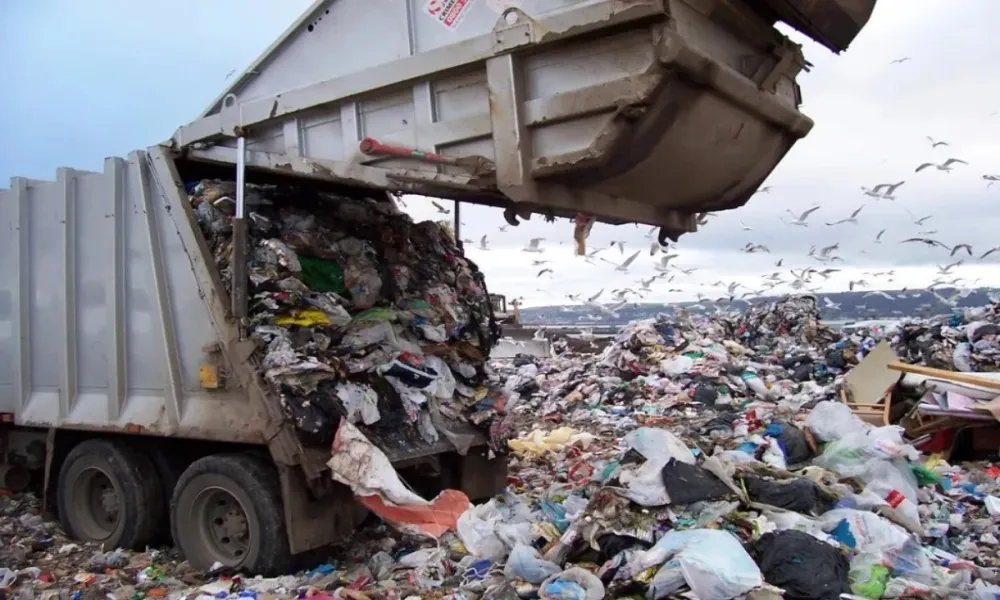While public concern often focuses on fires erupting at illegal dumps/uncontrolled landfills (ΧΑΔΑ), the far larger “powder kegs” are the sanitary landfills (ΧΥΤΑ), the residual waste landfill (ΧΥΤΥ) and the Integrated Waste Management Facilities (OEDA / ΟΕΔΑ). As highlighted in a joint session of the House Committees on Interior, Agriculture and Environment on 18 September 2025, the methane generated by buried waste, both highly flammable and a potent greenhouse gas, is neither flared off nor captured for energy. This non-compliance with EU directives leaves buried material dangerously combustible. Safeguards against intentional or careless ignition are also weak, further heightening fire risk.
The debate was triggered by the fire at the Paphos landfill, which broke out on 24 July, the very same day as the devastating Limassol blaze, forcing firefighting forces to battle on multiple fronts. Paphos' landfill is particularly exposed, as a public road cuts right through it, leaving it open to accidental or deliberate ignition. The same issue resurfaced recently in Larnaca, where on 13 September a blaze broke out at the Integrated Waste Management Plant (IWMP/ΧΥΤΥ) in Koshi. Heavy machinery had to bury the piles under soil, a painstaking operation that lasted hours.
Management failings
Taken together, landfills (ΧΥΤΑ), residual waste landfills (ΧΥΤΥ), illegal dumps (ΧΑΔΑ), integrated facilities (OEDA / ΟΕΔΑ) and recycling plants, Cyprus’ waste system resembles an explosive cocktail. It undermines citizens’ sense of safety and environmental protection while the state still lacks the political will, resources and tools to deal with it. This, despite Cyprus preparing to assume the EU presidency in a few months, while already mired in infringement procedures from Brussels. Most of the island’s rubbish still ends up buried: at the Paphos landfill, the collapsed Pentakomo Integrated Waste Management Facility (OEDA) in Limassol, and partly at the Kosi facility.
On trial in Europe
Cyprus’ first conviction by the EU stemmed from the operation of illegal dumps (ΧΑΔΑ). Under infringement case 2011/2005, the European Commission sent a warning letter in May 2011 and a reasoned opinion in January 2012 about the Vati and Kotsiatis landfills. The case went to the EU Court of Justice, which condemned Cyprus in July 2013. Yet years later, restoration and closure of the sites have still not been completed, and deadlines have been repeatedly missed. On 7 May 2025, the Commission again referred Cyprus to the Court for non-compliance.
Two further infringement cases are also underway: one for failing to pre-treat waste before landfilling, and another for breaching EU rules on packaging and electronic waste. The risks are clear: leachate pollutes groundwater, methane emissions worsen climate change, and recyclables are lost to Europe’s economy.
Cyprus is also exposed for burying untreated municipal waste, under infringement case 2021/2217. After a formal notice in December 2021 and a reasoned opinion in December 2024, referral to the EU Court is now expected.
Six steps to sanctions
An EU infringement case follows six steps: (1) investigation, (2) letter of formal notice, (3) reasoned opinion, (4) referral to the Court of Justice, (5) state compliance with the ruling, and (6) financial penalties for continued non-compliance. Cyprus is stuck in this cycle.
Every case problematic
“The poor management of waste leads either deliberately or accidentally to its burning and inevitably to fires,” said Kleitos Papastyliannou, Environmental Policy Officer at Terra Cypria. He noted that today, illegal dumps (ΧΑΔΑ), landfills (ΧΥΤΑ), residual landfills (ΧΥΤΥ), integrated facilities (OEDA), recycling plants, and even vast piles of tyres at Kalavasos all pose heightened fire risks.
He cited Terra Cypria’s record of major waste-related blazes in the past 15 years:
-
11 June 2024, Paphos district: Drynia–Polemi–Kourdakas–Choulou–Lemona–Psathi–Agios Dimitrianos–Amargeti. Cause: waste burning. Burnt area: 1,490 hectares.
-
4 August 2023, Limassol district: Ypsonas–Alassa–Apsiou–Korfi–Apesia–Paramytha–Fasoula–Gerasa. Cause: waste burning. Burnt area: 882 hectares.
-
21 August 2011, Limassol district: Anogyra, Kapsalia, Ha Potami area. Cause: waste burning. Burnt area: 665 hectares.
Other examples include recycling centres (Kalavasos 2022, Geri 2023, Mari 2025), landfills (ΧΥΤΑ) such as Marathounta (2025), and integrated facilities (OEDA) such as Pentakomo (2024 & 2025).
Communities Under Fire Risk
Left AKEL MP Valentinos Fakontis described conditions at the Paphos landfill:
“Fires break out often. When strong winds blow, residents live in fear. The landfill has become a giant dump. The first cell is full, a second was built, but equipment cannot compact the waste properly. Fire Service warnings were ignored: no firebreaks, no hoses. The last blaze, on the same day as Limassol’s, nearly reached Nata, Agia Varvara and Episkopi. Authorities must be held accountable. The landfill must function properly before the entire area becomes one unmanageable mass of rubbish.”
Rethink Waste Policy
Greens MP and Environment Committee chair Charalambos Theopemptou voiced concern on 18 September in Parliament:
“The Environment Department released significant funds for clean-ups, but only about one-third of communities cooperated. We must reassess why people dump illegally, why enforcement is absent, and why deterrents fail. If funding local communities doesn’t work, government must take central responsibility. We also need to find lawful ways to identify offenders and, crucially, ensure villages have realistic options for disposing of unwanted items. It’s the state’s duty to provide such services.”
